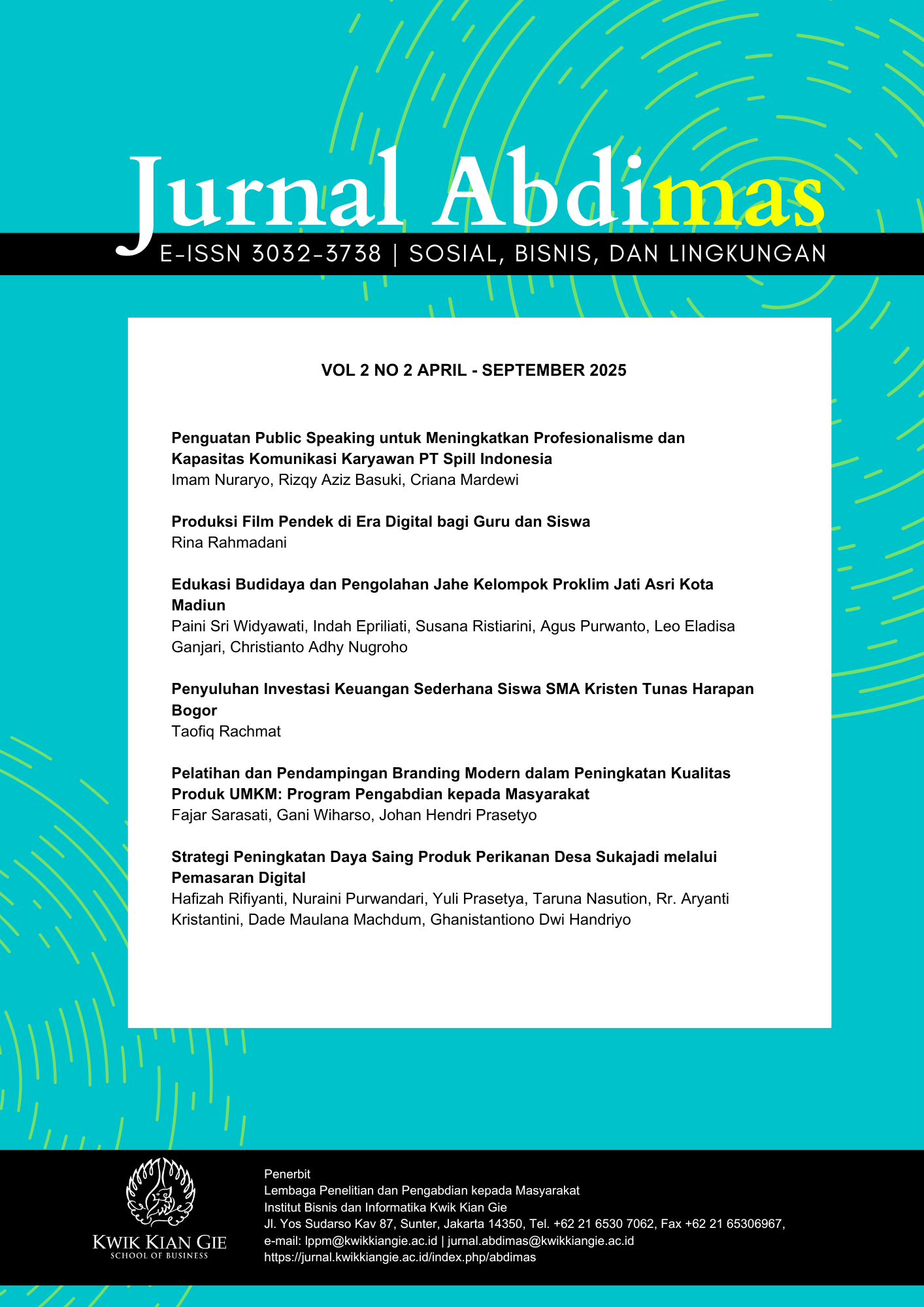Penyuluhan Investasi Keuangan Sederhana Siswa SMA Kristen Tunas Harapan Bogor
Main Article Content
Abstract
Giving basic financial investment education as a service to the community was done for students at Tunas Harapan Christian High School in Bogor. The point of this activity was to teach them the basics of understanding money and investing while they are still in school. This program was carried out because students do not know much about handling their money and planning safe investments, and they often spend too much without a plan. The topics covered included learning about what investing is, the different ways to invest that people usually use (like stocks, bonds, mutual funds, gold, and savings accounts), looking at the risks and possible rewards, advice on starting to invest with a small amount of money, and common mistakes to avoid. The ways used to carry out this training included interactive talks, question and answer times, sharing stories, and showing information with PowerPoint slides. The students were guided to understand how saving money, investing safely, and reaching money goals in the future are all connected. The results of this activity showed that the students knew more about basic investing ideas, were aware of the risks, and could plan how to start managing their own money. With this education, it is hoped that students can develop good, thrifty, and planned money habits from an early age.
Downloads
Article Details

This work is licensed under a Creative Commons Attribution-NonCommercial-ShareAlike 4.0 International License.
References
Atkinson, A., & Messy, F. (2012). Measuring financial literacy: Results of the OECD / International Network on Financial Education (INFE) pilot study. OECD Publishing. https://doi.org/10.1787/5k9csfs90fr4-en
Banerjee, A. V. (1992). A simple model of herd behavior. The Quarterly Journal of Economics, 107(3), 797–817. https://doi.org/10.2307/2118364
Black, P., & Wiliam, D. (1998). Assessment and classroom learning. Assessment in Education: Principles, Policy & Practice, 5(1), 7–74. https://doi.org/10.1080/0969595980050102
Bodie, Z., Kane, A., & Marcus, A. J. (2018). Investments (11th ed.). New York, NY: McGraw-Hill Education.
Bruner, J. S. (1961). The act of discovery. Harvard Educational Review, 31(1), 21–32.
Chen, H., & Volpe, R. P. (1998). An analysis of personal financial literacy among college students. Financial Services Review, 7(2), 107–128. https://doi.org/10.1016/S1057-0810(99)80006-7
Felder, R. M., & Silverman, L. K. (1988). Learning and teaching styles in engineering education. Engineering Education, 78(7), 674–681.
Johnson, D. W., & Johnson, R. T. (1999). Learning together and alone: Cooperative, competitive, and individualistic learning (5th ed.). Boston, MA: Allyn & Bacon.
Kolb, D. A. (1984). Experiential learning: Experience as the source of learning and development. Englewood Cliffs, NJ: Prentice Hall.
Lusardi, A., & Mitchell, O. S. (2014). The economic importance of financial literacy: Theory and evidence. Journal of Economic Literature, 52(1), 5–44. https://doi.org/10.1257/jel.52.1.5
Markowitz, H. (1952). Portfolio selection. The Journal of Finance, 7(1), 77–91. https://doi.org/10.1111/j.1540-6261.1952.tb01525.x
Mayer, R. E. (2009). Multimedia learning (2nd ed.). New York, NY: Cambridge University Press.
Mischel, W. (2014). The marshmallow test: Mastering self-control. New York, NY: Little, Brown and Company.
National Endowment for Financial Education. (2018). Reaching and teaching teens: Adolescent financial literacy. Retrieved from https://www.nefe.org
Organisation for Economic Co-operation and Development. (2020). OECD/INFE 2020 international survey of adult financial literacy. Paris: OECD Publishing. https://doi.org/10.1787/48ebd1ba-en
Otoritas Jasa Keuangan. (2022). Strategi Nasional Literasi Keuangan Indonesia 2021–2025. Jakarta: Otoritas Jasa Keuangan.
Przybylski, A. K., Murayama, K., DeHaan, C. R., & Gladwell, V. (2013). Motivational, emotional, and behavioral correlates of fear of missing out. Computers in Human Behavior, 29(4), 1841–1848. https://doi.org/10.1016/j.chb.2013.02.014
Sharpe, W. F. (1964). Capital asset prices: A theory of market equilibrium under conditions of risk. The Journal of Finance, 19(3), 425–442. https://doi.org/10.1111/j.1540-6261.1964.tb02865.x
Vygotsky, L. S. (1978). Mind in society: The development of higher psychological processes. Cambridge, MA: Harvard University Press.
World Bank. (2014). Global financial development report 2014: Financial inclusion. Washington, DC: World Bank. https://doi.org/10.1596/978-0-8213-9985-9
